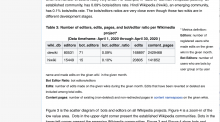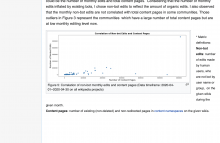There are two definitions we have explored for emerging communities one around contributors and another around supportive work about article creation
- communities with less than 5 technical contributors
- if you look at tools and bots written you can also look at the number of edits coming (in percentage) from tools/bots in cloud environment to that one wiki, this number would be between 0 and 5% (for healthy wikis is 10%) . In some cases for some wikis all this work is done manually and thus the number of 'automated' edits is 0%
Neither of these two 'definitions' include large amounts of data (thus the 'thick data' label)











